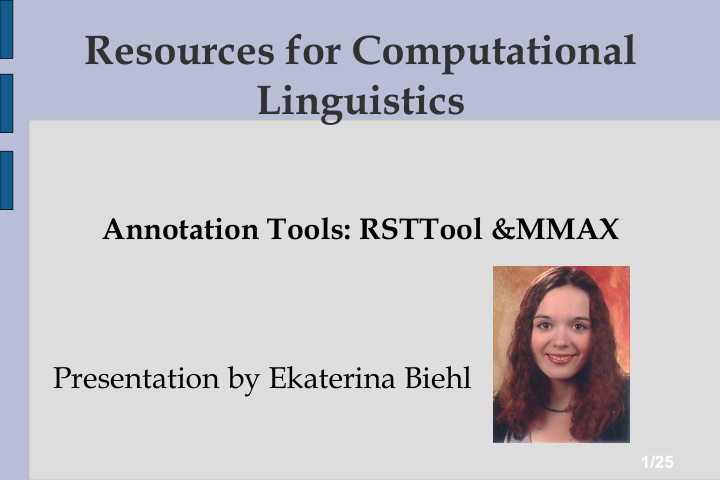



Resources for Computational Linguistics Annotation Tools: RSTTool &MMAX Presentation by Ekaterina Biehl 1/25
In the Last Session ● Corpus Linguistic; ● Corpus; ● Unannotated; ● Annotated; ● Annotation; ● Levels of Annotation; ● POS- Tagging; ● Grammatical Parsing; ● Semantic Tagging; ● Discoursal and Text Annotation (RST, Discourse Tags, AnaphoricAnnotation); 2/25 ● Prosodic Annotation....
So, We need annotation tools! 3/25
Annotation Tools What is important? • should be able to do your task; • speed, stability, and practical usability; • ready and easy to use; • standardized input/output format ( XML ). 4/25
Today' Session 1. Text analysis => RSTTool ; 2. Multi-level annotation => MMAX ; 3. Examples. 5/25
Questions 1. What is to be annotated? 2.What are the markables ? 3. What is the guideline and annotation scheme ? 6/25
RSTTool Michael O'Donnell 7/25
RSTTool Graphical interface to facilitate the marking up of the RST structure of text => - segmentation of text; - graphical linking of the segments into an RST Tree. 8/25
RST = Rhetorical Structure Theory ● offers an explanation to COHERENT texts ● i.e. with no gaps and non-sequitures; ● describes text structure by means of „BUILDING BLOCKS“ at ● principal level „nuclearity“ <> „relations“; ● second level schemas. 9/25
„Nuclearity“ Mononuclear: Nucleus => Satellite Multi-nuclear: Span = Other Span 10/25
Rhetorical Structure Theory Example of the analysis tree: 11/25
RSTTool Example of the annotation 12/25
RSTTool: Summary 1. Annotation tool for particular purpose; 2.Tree visualisation; 3. Graphical interface; 4. Analysis time reduction; 5. Statistics. 13/25
MMAX Dr. Michael Strube was developed at EML Reserch, Heidelberg Christoph Müller 14/25
MMAX ● „light-weight and highly customizable annotation tool“ (Müller & Strube (2001a, 2001b, 2003); • supports the multi-level annotation of (potentially multi-modal) corpora; • based on the concept of markables carrying attributes and standing in certain relations to each other. 15/25
Consepts: Markable ● carries the annotation information; ● can be defined on arbitrary levels of linguistics annotation; ● is an entity that can consists of arbitrary sets of elements from the data base; 16/25
Consepts: Markable II ● can represent multiple levels of linguistic description; ● can be overlapping or discontinious. the principle of STAND-OFF annotation 17/25
Concepts: Attributes ● markables can have arbitrarily many attributes (name- value pairs); • nominal attributes which have a closed set of possible values. 18/25
Concepts: Relations relations between markables: • member-relation : markables having the same value in an attribute; ● pointer-relation : directed relations between a source markable and arbitrarily many target markables. 19/25
Guideline => Annotation Scheme Guideline =Instruction Annotation scheme = formal guideline: ● describes which phenomena are to be annotated using which set of attributes; ● defines all attributes for a linguistic level. 20/25
MMAX: the Tool ● is written in Java; ● XML; ● consists of main annotation window, Search window, attribute window. 21/25
E X tensible M arkup L anguage ● XML is a markup language much like HTML; ● XML was designed to describe data and to focus on what data is; ● XML tags are not predefined. You must define your own tags ● XML does not DO anything. XML was created to structure, store and to send information. 22/25
MMAX: the Tool Example of the annotation 23/25
MMAX: Summary ● annotation as set of simple concepts based on the notion of „markable“; ● almost any kind of annotation can be done; ● multiple levels; ● stand-off annotation; ● can express highly customizable annotation schemes; ● is compartible with ISO standard (ISO TC37 SC4). 24/25
Conclusion: RSTTool: Rhetorical Structure Theory; tree visualization; dedicated annotation tool. MMAX: flexile tool for almost any kind of annotation; annotation refers to markables; simple and customisable. 25/25
References: Corpus Linguistics- Annotation : http://www.coli.uni-saarland.de/courses/korbay/Complingres/Slides/corpora.pdf ● http://bowland-files.lancs.ac.uk/monkey/ihe/linguistics/contents.htm ● http://coli.lili.uni-bielefeld.de/forschung/xbrac/pdf/xbrac-dipperetal-sfb.pdf - search='MMAX%2 ● RSTTool: http://www.wagsoft.com/RSTTool ● http://www.sfu.ca/rst ● MMAX: http://www.eml-research.de/english/research/nlp/download/sigdial03.pdf ● http://www.eml-research.de/english/research/nlp/download/mmax.php ● XML: http://www.w3schools.com/ ● ISO: http://www.tc37sc4.org ● TEI http://www.tei-c.org/ ● 26/25
Recommend
More recommend